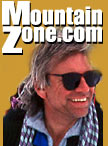Hiking In New Zealand
North Island
February 4, 2002
| |||
The small city of Taupo, on the shores of the largest lake in New Zealand, is all about wild trout. But since I don't know one end of fishing pole from another, the legendary browns and rainbows of this country are treasures lost on me. My accommodation by the lake shore, the Albion Lodge, is famous for its fishing guides. But in the friendly spirit of this island country, the people who run the Albion showed me what I needed to know about hiking Taupo, and helped me get where I needed to go.
I warmed up with a hike out to Kawakawa Bay on the wild west side of the lake with a Department of Conservation ranger named Ralph Turner. Expansive Lake Taupo, with the volcanoes of Tongariro, Ngauruhoe and Ruapehu rising at its southern end, is a 620-square kilometer wonder formed by a volcanic eruption so big it darkened the sun as far away as China. The lake is dotted with rocks carved by the Maori people who have lived in this volcanic area for so long. Turner, affable and reserved like so many of the Kiwis, spoke of his personal dream of seeing a trail built completely around the lake, a project that at present is more vision than reality.
| |||
Maoris have lived here for as long as these ancient trees, and the indigenous people of the country attach a strong sense of spirituality to this forest. As with most of the best hikes in New Zealand, there's a guided option within the Whirinaki Forest, one that includes a couple of nights at an established forest camp complete with meals and other creature comforts. The multi-day outing is led by Maori guides whose intimate knowledge of the area makes the journey as much of a cultural experience as a wilderness one.
On the day Brian drove from the Albion Lodge to fetch me at the conclusion of the Whirinaki trip, we made the short journey over to one of the many active geothermal areas in Taupo. A short hike took us through a landscape of steaming fumeroles, bubbling pits of hot mud, and technicolor pools tinged by various oxides. The startlingly variety of the terrain-from lush rain forests to smoldering lunar landscapes-is just part of what makes hiking in New Zealand so mind-blowing.
| "On our way back to Taupo, Brian suddenly started driving with uncharacteristic haste, finally revealing that we had 'only 20 minutes to find a place to watch the Melbourne Cup.'" |
|||||
We ended up in a country pub full of farmers, sheep shearers, diary men, townspeople and local Maoris. As the bar man brought the first beers, Brian informed me that betting was mandatory, including by me, as even total ignorance was no excuse from participating in the tradition. So I scanned the large field of contestants and, being a journalist, picked an Irish entry named Media Puzzle on which to lay down my $5 notes (down here, the bills sport Hillary's face, not Abe Lincoln's). Naturally, my dumb, beginner's luck kicked in big time. Much to the annoyance of everyone in the pub, when the screaming was over, the "Yank's" horse had won the race. My proceeds were cheerfully paid in Speights Ale, and it took hours for me and my new friends to drink all that beer. The afternoon in that country pub showed me more about New Zealand that I could have discovered in weeks of doing something else.
| |||
A highlight of the Tongariro National Park was the Grand Chateau, a huge hotel of old world charm built in the 1920s in the tradition of the Canadian railroad hotels. It rises out of the grasses and volcanic features of the park like a vision, and an incredibly comfortable one after a gray, windy and cold day up on the hills. The place is a bit pricey, but its location makes it irresistible when you're hiking the park for just a few days. Warming up by the fire in the ornate lobby, I was reading an old copy of a New Zealand mountaineering magazine, an article about the country's "haunted huts" on some popoular alpine routes. I almost spilled my Irish coffee when one of the supposedly haunted locales was not some remote hut, but the third floor of the Grand Chateau-right where my room was! But after a last meal of New Zealand lamb and a Hawk's Bay cabernet, I crawled off to bed early and slept soundly, either unmolested by lurking ghosts of the past or too tired to notice. The next day was the beginning of the return journey, so it was off to the tiny Taupo airport for the propeller job back to Auckland and the sad end to an amazing trip--a tramping smorgasbord that can only be described as "good as gold."
— Peter Potterfield, MountainZone.com Staff





